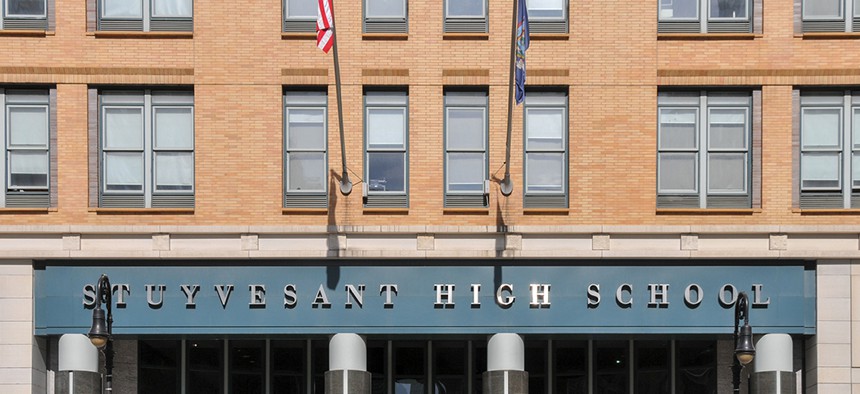Education
The way to diversify specialized high schools is to open more of them
Let’s end the zero-sum competition between ethnic groups in New York City's specialized high schools and create more opportunities for everyone.

Stuyvesant High School Felix Lipov / Shutterstock
Every year around 30,000 8th graders take the SHSAT, the high-stakes entrance exam for New York City’s eight coveted specialized high schools.
In March, 25,000 ambitious teenagers get the disappointing news that they will not be offered admission to any of those schools.
Recently, Mayor Bill de Blasio’s controversial plan to increase the paltry number of African-American and Latino students in the specialized schools has been met with much criticism, particularly from the city’s growing Asian-American community. Currently, the majority of students at Stuyvesant, Bronx Science and Brooklyn Tech are of Asian descent. At Stuyvesant 73 percent of the student body is Asian-American, compared to 1 percent African-American and 3 percent Latino. The citywide public school mix is much different: 26 percent African-American, 40 percent Latino and only 16 percent Asian-American.
In the zero-sum game of balancing the racial demographics at these schools, a win for one group results in a loss for another.
There is a third way, a much better plan that can satisfy all constituencies in the city while adding more educational jewels to the crown in the public high school system.
When demand for an innovative new early-college program outpaced supply, in 2008, Bard High School Early College created a second campus, initially called Bard II, now Bard High School Early College Queens. It has been a huge success and allows another 600 motivated high school students the opportunity to get a jump on their college studies while in high school.
So, why not Stuyvesant II in Harlem? Bronx Science II in Mott Haven? Brooklyn Tech II in Crown Heights?
The creation of these three new specialized high schools, which would replicate the first-class curriculums and rigor of their original counterparts, would allow another 2,500 of the 25,000 disappointed SHSAT test takers attain their dream of attending school at a crown jewel of the New York City public education system.
There is a successful precedent for this. In the early 2000s, Harold Levy, who was then the New York City schools chancellor, came up with an innovative plan to add three more specialized schools around the five boroughs to complement the big three, Stuyvesant, Bronx Science and Brooklyn Tech, that had produced generations of New York’s leaders. (A fourth prestigious specialized high school, Fiorello H. LaGuardia High School of Music & Art and Performing Arts, has a very different academic program and admissions process than the others.) That additional group eventually grew to five, including Brooklyn Latin School, Staten Island Technical High School, High School for Math, Science and Engineering at City College, Queens High School for the Sciences at York College, and High School of American Studies at Lehman College. All have become popular and successful schools, widening the pool of students receiving a high-level college preparatory education. With this expansion, the number of available seats in specialized high schools rose from 15,000 to 18,350.
This would complement de Blasio’s very wise plan to revive the Discovery Program in the current eight specialized schools. The Discovery Program was created in 1972 as part of the Calandra-Hecht bill that enshrined the SHSAT test as the sole admission criterion for Stuyvesant, Bronx Science and Brooklyn Tech. It allowed the schools to accept students who are from economically disadvantaged backgrounds and fall just below the acceptance cutoff score, on the condition that they attend a summer enrichment program. The intent was to admit more African-American and Latino students, but the influx of high-scoring, low-income Asian-Americans made that impossible and the program was discontinued at Stuyvesant and Bronx Science early in the Bloomberg administration – only Brooklyn Tech kept it. While it has been recently reinstituted under de Blasio, it has primarily benefited Asian-Americans and barely made a dent in the underrepresentation of African-Americans and Latinos.
Now, de Blasio wants to make it work better by applying it only to students who are both from low-income backgrounds and from predominantly low-income middle schools. This will increase the number of African-American and Latino students, without penalizing the most disadvantaged Asian-American and white students. With Discovery’s reform, the percentage of African Americans and Latinos in these schools should increase from 10 percent to at least 16 percent, an incremental improvement but still far from where we need to be.
Three new schools would potentially add at least another 500 seats per year – 2,000 in total – for African-American and Latino scholars. This would further improve the racial balance at the specialized schools while not displacing any deserving scholars.
And because these would be part of an overall expansion in specialized education in New York, every minority group would benefit. There would be no losers, only winners.
One of us has experience in starting successful new high schools — in 2002, Tom Allon was on the task force that created Eleanor Roosevelt High School and then, in 2009, he worked with then-Councilwoman Gale Brewer to create Frank McCourt High School.
The lesson in creating these two new schools is that when there is the political will, we can move mountains to improve our education system.
With the current heightened attention on specialized education, now is the time to create more specialized high schools to meet the steady supply of smart and eager 8th graders who look to their elected leaders to provide the educational ladder to future success.

NEXT STORY: MTA should fast forward disabled accessibility in existing projects